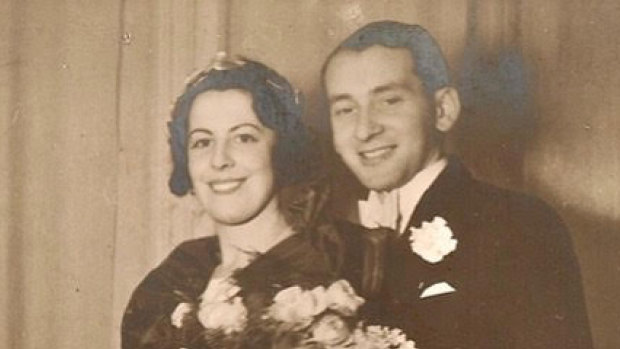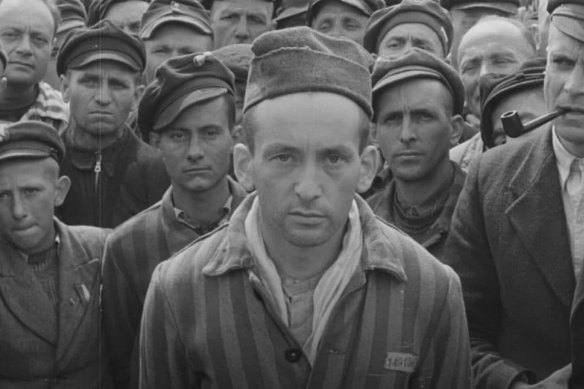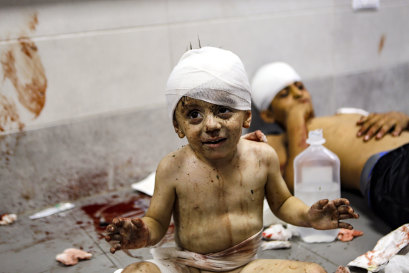This was published 1 year ago
Opinion
I tell my family’s Holocaust story while I advocate for Palestinians and Israelis
Karen Kirsten
Writer, educatorI was 11 the day my mother picked me up early from school, her usually cheerful face etched with worry. Someone with a blowtorch had burned swastikas across her aunt’s lawn. Bordering it was the two-roomed granny flat where she and my grandparents lived when they arrived in Australia as refugees after surviving the Holocaust.
As a child, I didn’t understand anti-Jewish hate, or my DNA. My atheist grandparents didn’t discuss extermination camps. They brushed off my questions. My grandmother told me she’d tattooed her phone number on her forearm, so she’d never forget it. But the day my mother explained the swastikas, singed into grass where she’d skipped rope, finally far from jack-booted Nazis, I stiffened like a fly glued to a trap. My fingertips buzzed. People really don’t like us, I thought.

The author Karen Kirsten’s grandparents, Mieczysław and Alicja Dortheimer, on their wedding day in Warsaw, Poland.
That is still true. As a Holocaust educator who shares my family’s story in schools, since October 7 and the unbearable suffering of innocent people in Israel and Gaza, I have been thinking a lot about how to talk to young people about the surge of anti-Jewish and anti-Arab hate.
In the US, where I live, I observed university presidents, who provide safe spaces, anti-racist policies and micro-aggression guidelines to protect minority student groups, dodge questions about whether calling for the genocide of Jews violated their codes of conduct, downplaying the harassment of Jewish students, who feel anything but safe or protected.
This after police arrested a Cornell University student for threatening to kill Jewish students. In New York City, Cooper Union’s Jewish students were locked in a library as protesters banged on the door.
I wish liberal-minded educators who parrot inclusivity would study history to see how misconceptions and conspiracies led to anti-Jewish pogroms, how Jews were nearly exterminated by race laws and white supremacy.

Karen Kirsten’s grandfather, Mieczyslaw (Mietek) Dortheimer, at the Dachau Concentration Camp on May 5, 1945, during an interview he conducted days after the camp’s liberation. That interview, courtesy of the United States Holocaust Museum, is now on display at the Melbourne Holocaust Museum.Credit: United States Holocaust Museum
When I read about harassment on campuses, I see a pattern. Universities in my grandparents’ Poland were hotbeds long before Hitler invaded. Although my grandfather escaped the Jewish quotas, staff ordered him to sit on “ghetto benches” in segregated lecture halls. He knew the “context” of chants to eliminate Jews. Youth all across Poland attacked Jews on the streets and in university hallways.
At my grandfather’s university, they herded Jews into courtyards and slashed them with razors tied to long poles. Even after they pushed Jews out of a third-floor window, the university and police took no action.
Tolerating harassment leads to normalisation, leads to dehumanising “others”, the denial of rights, then all kinds of violence. Ultimately, my grandfather could not practise law because of anti-Jewish bans on liberal professions. After Nazi Germany invaded, they sentenced my grandmother to slave labour in Auschwitz, my grandfather in Dachau, and their parents to the gas chambers.
For me, it is important to tell students my family story because, while absolutes and certainties may anchor us, there is nothing simple about history or human behaviour. Year 10 students’ eyes light up when I tell them about the Polish people who risked their lives to save my mother. But when they learn a Nazi SS officer who tortured and killed women also saved her, they grapple with the “good” versus “evil” binary.

We can cry for Palestinian children being killed and injured in the conflict with Israel, and for the Israeli victims of Hamas.Credit: Associated Press
The fact is, despite his horrific behaviour, without him, I wouldn’t exist. When students learn my Jewish grandparents were atheist, that Catholic sisters hid my mother during the war, that she later raised me Christian, they question assumptions about ethnicity and identity.
Today, about half of the world’s Jewish population is not religious and the majority lives outside Israel. Like the man who fired a shotgun outside a temple in New York this month, many conflate all Jewish people with Israel, a country I have never visited.
Helping young people to embrace complexity eschews assumptions, stereotypes and binary thinking. Empathy isn’t a zero-sum emotion. You can cry for dust-covered, bleeding children in Gaza, and for Naama Levy who Hamas took hostage, then filmed as they paraded her like a trophy, red from her crotch running down her tracksuit pants.
You can call for a ceasefire and simultaneously demand Hamas release Israeli hostages. You can advocate for a Palestinian state alongside an Israel where all people feel safe.
I am not a diplomat and don’t know how to solve the current tragedy. I do know it’s critical for young people to listen, to empathise with one another’s grief and pain, to choose words carefully, to de-escalate hate rather than incite or inflame. Muslim and Jewish students at a New York high school agreed on their social obligations, then created safe opportunities to listen to each other.
Facing History’s global resources for teachers help ground student conversations about the Israel-Hamas war in respect for others’ humanity. Similarly, Seeds of Peace teaches youth in the Middle East skills to converge across lines of conflict. These “seeds” organise campus dialogue.
And to avoid antisemitic and Islamophobic hate speech, the UK-based Solutions Not Sides educational program recommends we not hold all Jewish people responsible for decisions of Israeli leaders, or all Muslims or Arab people responsible for decisions of Palestinian leaders or Hamas.
I don’t want to march with people who pick a side and post un-nuanced slogans that delegitimise the agony of either Israelis or Gazans. I want to be like my Palestinian friend who prays for peace and love for all innocent civilians. I want to facilitate difficult discussions with students and prepare them for the reality of our complex world.
Karen Kirsten is a US-based Australian author of the World War II memoir Irena’s Gift. She is an educator who speaks in high schools and universities.
Get a weekly wrap of views that will challenge, champion and inform your own. Sign up for our Opinion newsletter.